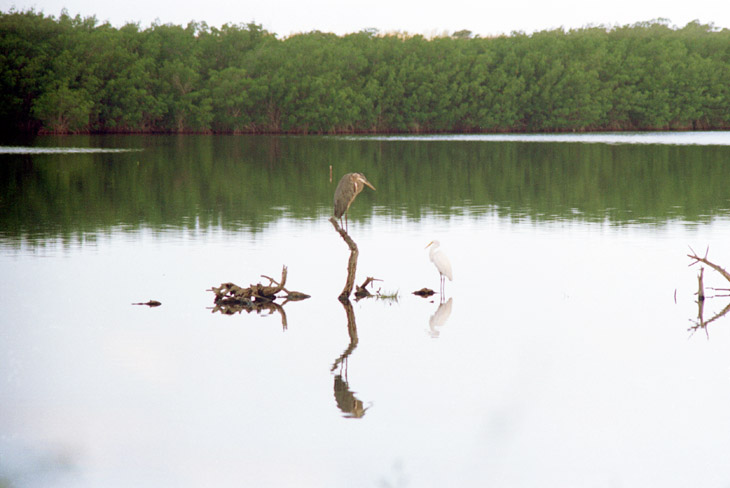It’s been a busy week, and I haven’t had much time to even look at some of the drafts I have in the folder, much less tackle anything new to write, and I’m not sure this will improve before christmas. So for now, we’ll step onto the Wayback Crack and break causality’s back. And here, you didn’t think I could turn a metaphor…
In a previous episode, I featured my first wild gator pic, taken at J.N. “Ding” Darling Wildlife Refuge on Sanibel Island, so on the first trip on my own to Florida a couple of years later, I had to return. That day, unfortunately, was incredibly slow – the weather was a little off, and there simply wasn’t much of anything to see, which is how it goes sometimes. You can’t judge a locale based on one visit, because you might simply have gotten there at a dead time (or a remarkably active one.)
Alongside a large pool that turned out to be a shallow flood plain, I spotted a couple of wading birds in the distance, a great blue heron (Ardea herodias) and a great egret (Ardea alba) – or at least, it was probably a great egret. It might also have been a great white heron, which is a white phase of the great blue that is found only in Florida and down into the Caribbean. The way to distinguish them is the color of the legs: egrets have black legs, while the herons have tan legs. The photo wasn’t distinct enough to display this effectively.

The driftwood and the reflections were a nice touch, though the hazy sky took away a lot of the color vibrancy and any kind of interesting background. The way the undergrowth alongside the pool and access road were, this was the only vantage I could get, and I wasn’t wild about the background. But there’s a simple trick that I encourage people to remember, which is how three-dimensional the world is. By changing our own shooting position, we can change the position of the subject and the background in the frame, and sometimes get a composition that works better. In this case, I realized I needed to be higher.
Florida is flat, and Sanibel doubly so – there was no hill to climb, and not even any trees that might serve as a perch. So I clambered onto the roof of my little Corolla, standing carefully along the roof edge where the framing could support my weight and I could avoid the sunroof. This was akin to balancing on a beam, nothing difficult, but slightly more challenging when then looking through a telephoto lens and trying to compose the shot. It worked, however.

Now, this is a demonstration of the change that comes from position, but it’s not a great shot. A small portion of the blame can be placed on negative film, which is grainier and less vibrant than most slide films – the reason why, a dozen or so years ago, editors would only buy slides for publication, a switch I made a few years after this trip (but before the next.) More blame falls on me, however. The light simply wasn’t supportive of such a composition, and my framing is a little too centered. See that driftwood off to the right in the previous image? I (probably) could have shifted my aim to the right, putting more driftwood into the frame and setting the birds off-center to the left, to make a little more dynamic shot. I say I probably could have shifted more to the right, but it’s possible that there were more distractions and unattractive gunk over there; I can’t remember everything about trips from 20-odd years ago. I did, at least, get the foreground foliage out of the shot, which was what created the extremely faint blotches in the lower part of the frame.
So while we’re talking about composing, let’s look at the details. The great blue heron came up more distinct when framed against the bright reflecting water, but the egret still isn’t standing out well. Ideally, one would work the background to be dark behind a light subject, and light behind a dark one, just to boost that contrast and attract the eye better. Had the sky been blue with fluffy clouds, I might have tried to put the egret against blue sky and the heron against a white cloud. Note, also, that the hue of the water may change with angle, faintly visible here as it becomes darker towards the bottom of the frame. And of course, shooting at dawn just as the sun peeked over the foliage and illuminated the birds in an orange glow would have been nice. Birds don’t spend their nights down in reach of predators, though, so such a thing might not have been possible at sunrise anyway…
Though this shot spent a few years up on my wall (on the ‘beach’ wall; I also had a ‘forest’ wall,) I’ve moved on and don’t think it’s a worthwhile effort anymore. This happens: shots you might have been really proud of at one time may later become viewed with disdain, and this is a good thing. It means you’re improving.



















































